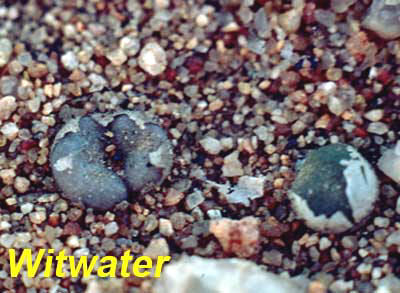This article is about the discovery and planting of conophytum depressum subsp. depressum by Terry Smale, a British senior enthusiast。
本文出自于andyhuang.cn(番杏大杂烩)除特别标注之外,本站大部分文字图片均为原创,欢迎转载,转载时请留下原文链接
以下为原文:
My only encounter with C. depressum subsp. depressum in the wild was in the Khamiesberge, to the south-east of Leliefontein, an area that can be cold and even snowy during the winter. On our visit in April, there was frost on the car windscreen after we had camped overnight in the area. There is no way that I would have seen the plants without the help of my very good friend Steven Hammer because they are essentially buried in the grit in which they grow, one just has to look out for small signs at ground level. The wild specimens were only one- or two-headed and would therefore fit with the naturally short-lived theory. It has been reported to occur over quite a wide area of Namaqualand, but few people have seen the various populations because of the cryptic nature of the plants.
Steven had this taxon in cultivation at that time in the late 1980s and provided me with some seed. Unlike most conos, the seed did not germinate well but the ones that did germinate grew on quite quickly and flowered at around two years of age. They subsequently died and I failed to produce a second generation in my greenhouse. I have not grown it since. My experiences essentially mirrored those of Steven who was based in New Mexico at the time and the taxon does seem to be almost a biennial or short-lived perennial, growing for a couple of years, flowering, producing seeds and then dying. On the same field expedition in 1988, we encountered plants of what became the holotype of C. depressum subsp. perdurans when described in “Dumpling and his Wife” in 2001. I found the plants in a grit pan on the farm Rietfontein (south-east of Springbok) where just a seed pod betrayed the presence of a thriving colony buried in the grit. Neighbouring grit pans were barren, so why was one particularly attractive to the subpecies? Steven had also seen it two years earlier on the neighbouring farm Silverfontein. Brought into cultivation, this material has been firmly perennial and built up into clusters to neatly fill a 6cm pot; I still have vegetatively-propagated descendants of the original plants. The orange flowers are larger than those of subsp. depressum and are not self-fertile. Subsp. perdurans obviously got its name from an ability to persist into old age and fits into the tricky rather than the near-impossible category. Like the type subspecies, seeds often do not germinate well, but a stock that I have had recently from a population to the north-east of Rietfontein has behaved much better in this respect and I have been able to distribute seedlings.
以下为机器+人工翻译:
我唯一一次在野外遇到C.Deprespum位于Leliefontein东南部的Khamiesberge,这个地区冬天很冷,甚至下雪。在我们四月份的访问中,我们在该地区露营过夜后,汽车挡风玻璃上结了霜。如果没有我的好朋友史蒂文·哈默的帮助,我是不可能看到这些植物的,因为它们基本上埋在它们生长的沙砾中,人们只需注意地面上的小标志。野生标本只有一头或两头,因此符合自然短命理论。据报道,它发生在纳马夸兰相当大的地区,但由于植物的神秘性,很少有人见过不同的种群。
史蒂文在20世纪80年代末有这个分类群在种植,并为我提供了一些种子。与大多数肉锥不同的是,他的种子不好发芽,但那些发芽的种子生长得很快,在两年左右开花。他们后来死了,我没能在温室里培育出第二代。从那以后我再也没有种过。我的经历基本上反映了史蒂文当时在新墨西哥州的经历,这个分类群似乎几乎是两年生或短命的多年生植物,生长了几年,开花,产生种子,然后死亡。在1988年的同一次野外考察中,我们遇到了2001年在《Dumpling and his Wife》中描述的后来被称为C. depressum subsp. perdurans的植物。我在Rietfontein农场(Springbok东南部)的一个沙子盆地里发现了这些植物,那里只有一个种子荚暴露出一个被沙砾掩埋的欣欣向荣的殖民地。邻近的沙子盆地是贫瘠的,所以为什么一个沙子盆地对亚种特别有吸引力?两年前,史蒂文也曾在邻近的西尔弗方丹农场见过它。种植时,这种材料已经牢固地多年生,并成簇整齐地填满一个6厘米的罐子;我仍然有原始植物的无性繁殖后代。橙色的花比C. depressum subsp的大而且不能自我繁殖。subsp. perdurans的名字显然来自于一种能够坚持到老年的能力,它属于棘手的范畴,而不是近乎不可能的范畴。。和模式亚种一样,种子通常发芽不好,但我最近从Rietfontein东北部的一个种群中得到的一个种群在这方面表现得更好,我能够分配幼苗。
原文地址《TS文章系列-THE DIFFICULT CONOPHYTUMS:Conophytum depressum》

发表评论